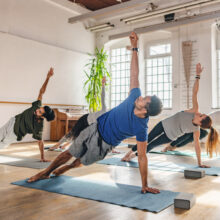Break a Sweat in Cooler Temps: Cold Weather Workout Tips
- Published: Monday, October 5th 2015
- in Fitness

by Danielle Dunn
Exercising during the cooler weather has a lot of benefits, perhaps even more than at other time of the year. You have more energy and expend more calories. However, working out in the cold weather can be more of a challenge. Do you dread exercising in cold weather? Do you stay away from using a treadmill or cycling indoors? Cold weather can discourage even the most motivated exercisers, but don’t let cold weather spoil your fitness goals this fall and winter. You know that keeping active during these seasons maintains the muscular strength and cardio-respiratory endurance you worked on all year. Remember these cold weather workout tips to still get your sweat on during the chillier months! Stay fit, motivated, and warm as the weather begins to cool down.
- Dress in layers: Exercise generates a considerable amount of heat; even enough to make you feel like it’s much warmer than it really is. However, once the sweat starts to dry, this will make you feel chilled. Dress in layers that you can remove as soon as you start to sweat and then put back on afterwards. You may need to experiment before you find a combination of clothing that works well for you based on your exercise intensity. Keep in mind, too, that stop-and-go activities, such as mixing walking with running, can make you more vulnerable to the cold if you repeatedly work up a sweat and then get chilly. Dress in layers that can provide a trapped layer of dry air near the skin (avoid cotton). First, put on a thin layer of synthetic material, such as polypropylene, which draws sweat away from your body. Next, add a layer of fleece or wool for insulation. Top this with a waterproof, breathable outer layer.
- Protect your hands, feet, ears: When it’s cold, blood flow is concentrated away from the hands and feet to the center of the body to keep the internal organs warm and protected, leaving your hands and feet vulnerable to frostbite. Try wearing a thin pair of gloves under a pair of heavier gloves or mittens lined with wool or fleece. Put on the mittens or gloves before your hands become cold and then remove them if your hands begin to sweat. Don’t forget a hat or headband to protect your ears, which also are vulnerable to frostbite.
- Drink plenty of Fluids: You need to stay well hydrated when exercising in cold weather just as you do when exercising in warm weather. Drink water or sports drinks before, during and after your workout, even if you’re not thirsty. It may be harder to notice, but you can become just as dehydrated in the cold as in the heat from sweating, breathing and increased urine production. Because it’s hard to break into a sweat in cold weather, this may prevent you from perceiving that you need water. This is dangerous because you may get dehydrated and not even know it. People who engage in sports and exercise are more prone to get dehydrated. To see how much water weight you’ve lost, weigh yourself before and after a workout. If you’ve lost more than a pound of weight, you need to replenish with water.
- Remember Sunscreen: It’s as easy to get sunburned in the cold months as in warm months, even more so if you’re exercising in the snow or at high altitudes. Wear a sunscreen that blocks both UVA and UVB rays and has an SPF of at least 30. Additionally, use a lip balm that contains sunscreen and protect your eyes from snow and ice glare with dark glasses or goggles.
- Head Into the Wind: If possible, do the second half of your workout with the wind at your back. This way, you’re less likely to get chilled, especially if you’ve worked up a sweat. This may take some planning of your exercise route before you head out the door.
- Check with the weatherman: Always check the air temperature and wind chill factor before exercising in the cold. Check the temperature and wind conditions before you go out and do not exercise if conditions are dangerous. A danger does exist for individuals with exposed skin when the wind chill factor (combined effect of temperature and wind) falls below minus 20 degrees Fahrenheit.
- Warm the air: If temperatures are below your comfort level (usually around 0 degrees Fahrenheit), you need to warm the air you are breathing. It is advisable if you are exercising near the danger zone for skin exposure to warm the air being inhaled by wearing a scarf or mask over your nose and mouth to warm the air being inhaled.



